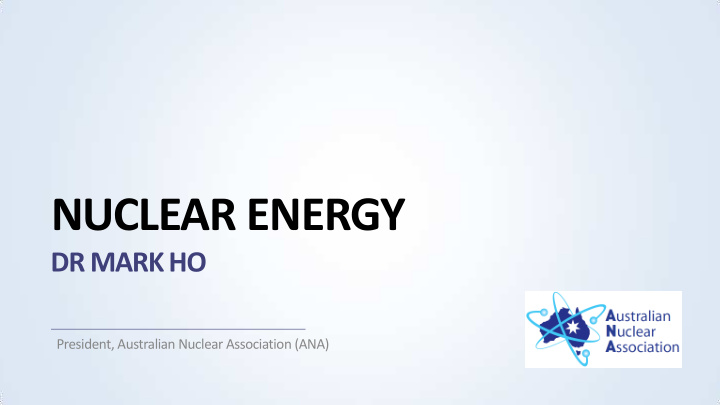



NUCLEAR ENERGY DR MARK HO President, Australian Nuclear Association (ANA)
OPAL: Australia’s research reactor
Coal’s scheduled retirement Source: AEMO, Integrated System Planning, 2018
NSW’s NEM Today Source MW % Capacity Factor (CF) MW x CF % Solar 578 3.2% 0.24 139 1.8% Coal 10,240 57.2% 0.61 6,246 81.6% Gas 1,964 11.0% 0.21 412 5.4% Gas (reciprocating) 166 0.9% 0.24 40 0.5% Hydroelectric 4,250 23.7% 0.14 595 7.8% Biomass 78 0.4% 0.24 19 0.2% Wind 634 3.5% 0.32 203 2.7% Total 17,910 100.0% Avg. Generation 7,654 100.0% Source: AEMO 2018
What about nuclear? Zero Constant carbon production base load power 80 80 - 92 92 % % capacity factor | 40 40 – 60+ 60+ years lifespan
Nuclear power reactors worldwide 10 10 % 447 447 2.5 trillion of world’s reactors in total kWh in 2018 electricity
Nuclear Power Generation 120 400 GW 98 100 World capacity total 10.2% 80 World’s electricity 63 [GW] 80% 60 46 Global av. capacity factor 36 40 28 24 20 14 13 10 9 0 Source: IAEA, 2019. PRIS
Nuclear & VRE generation Source: BP Statistical Review of World Energy, 2019
VRE grid penetration Source: IEA, 2018
Nuclear’s small environmental footprint Wind Solar Nuclear 1,010 1,010 km 2 607 607 km 2 6.5 6.5 km 2 Land required to produce 26 26 terawatt hours annually
Carbon intensity
France & Germany Source: http://data.worldbank.org/topic/climate-change
Renewables or Nuclear? (Why not Renewables & Nuclear?) Source: Fraunhofer ISE Germany, RTE France
Pressurised water reactor 300 300 units units worldwide Graphics: World Nuclear Association
Uranium power density 7 grams 600 600 L 800 800 kg 17 17 million of oil of coal thermal units of natural gas
Comparison COM OMBUSTI USTION ON OF OF HYD HYDROC OCARBONS NS CH 4 O 2 CO 2 H 2 O 9.2 eV Methane Oxygen Carbon Dioxide Water ENERGY NUCLEAR NU LEAR FI FISSIO SSION N OF OF UR URANI NIUM UM N U-235 Ba-141 + Kr-92 N 177,000,000 eV Free moving Radioactive Barium and Krypton Free moving ENERGY neutron uranium atom atoms neutrons
Fuel rods and fuel bundles Images: Rosatom
Spent fuel
Geological Storage Source: IAEA
What is Io Ionising Radiation? Alpha 20 (helium nucleus) Relative damage Beta 1 (electrons) 1 X-ray & gamma (EM waves) 5-20 Neutrons Combined measure: Sievert (Sv) Common measure: 1 µSv or 1 millionth of a Sievert
Every ryday examples Radiation worker 0.10 µSv 20,000 µSv Eating a banana limit (1 year) 40 µSv Flying to Bali Maximum Dose 100,000 µSv without risk of 100 µSv 2 weeks in Fukushima developing cancer 3,500 µSv Living in Australia 1 yr 4,000,000 µSv Fatal dose (background dose) 7,000 µSv CT chest scan
Taishan Units 1 & 2
Costs China, Sanmen: 2 Units US $5.06 B project $2.3 M / MW US, Vogtle: 2 Units US $19 B project $8.6 M / MW
Small modular reactors Mitsubishi APWR TM NuScale TM 60 MWe 1700 MWe
Smaller fu fuel load SMRs vs 1 GW reactors 96.1 tons of uranium dioxide (UO 2 ) 9.2 tons of uranium dioxide (UO 2 ) 60 MWe 1,100 MWe Source: Worrall (2015)
Cooling Reserv rvoir Source: NuScale
Passive safety. Walkaway safe.
Molten salt reactors Terrestrial Energy Terrapower (B. Gates) Integral Molten Salt Reactor Molten Chloride Fast Reactor
microReactors Graphics: Los Alamos National Lab
Questions?
Recommend
More recommend